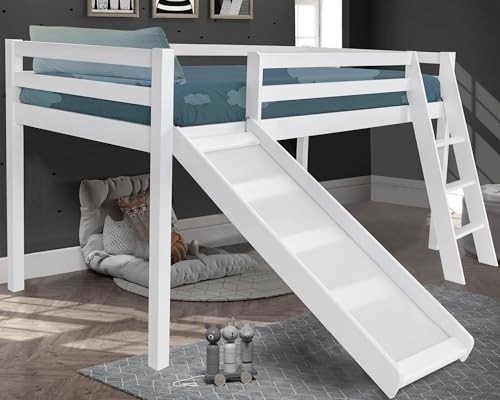Bunks: The Versatile Space-Saving Solution for Modern Living
In today's fast-paced world, where city home are shrinking and the demand for flexibility and functionality is increasing, bunks have actually emerged as a popular solution. Bunks are not simply a kind of bed; they represent an advanced method to taking full advantage of space, promoting social interaction, and supplying comfy sleeping arrangements. This post will explore the numerous types of bunks available, their benefits, and how they can change both small and big living areas.
Understanding Bunks: What Are They?
Bunks, typically described as bunk beds, are two or more beds stacked on top of each other. They are created to conserve flooring space, making them ideal for kids's rooms, hostels, and even adult living scenarios. Bunk beds are readily available in numerous designs and setups, from traditional designs to modern-day, designer interpretations.
Types of Bunks
| Kind of Bunk | Description |
|---|---|
| Twin-over-Twin | Two twin beds stacked on top of each other. Suitable for kids sharing a room. |
| Twin-over-Full | A twin bed on top and a larger complete bed on the bottom. Going Here for accommodating visitors. |
| Full-over-Full | 2 full-sized beds stacked together. Perfect for older children or adults. |
| L-Shaped Bunk Bed | Beds are arranged in an L shape, enabling a corner placement and added space underneath. |
| Loft Beds | Just the top bunk is present, leaving room for a desk, sofa, or storage below. |
| Triple Bunk Beds | Three beds stacked vertically, exceptional for taking full advantage of vertical space. |
Advantages of Using Bunks
- Space Efficiency: Bunks are designed to make use of vertical space, making them perfect for little bedrooms or homes where flooring space is restricted.
- Cost-efficient: Investing in a bunk bed can be more economical than acquiring multiple separate beds, specifically for growing households or those with frequent visitors.
- Flexible Designs: Many bunks featured add-ons, such as desks, storage drawers, or futons, enabling flexible use of the area.
- Social Interaction: Bunk beds invite sociability among brother or sisters and pals, cultivating a sense of connection.
- Innovative Use of Space: Bunk beds encourage imagination in space style, permitting lively styles and colorful design that can make a bedroom feel special and inviting.
Practical Considerations
- Height Limitations: When selecting a bunk bed, it is important to consider the height of the ceiling in the room. Procedure the space to guarantee there is appropriate clearance above the top bunk for safety and comfort.
- Weight Restrictions: Each bunk has a specific weight limit. Parents should evaluate the weight of those using it, particularly when it comes to adults or heavier adolescents sharing the bed.
- Safety Features: Features such as guardrails, strong ladders, and safety accreditations are crucial for ensuring the bunk bed's safety, especially for more youthful users.
Bunks for Various Living Situations
Household Homes
In household homes, bunks offer a useful service for siblings sharing a room or accommodating sleepovers. Bunk beds can be stylishly integrated into a child's space while providing sufficient space for play.
Hostels and Vacation Rentals
For hostels and vacation leasings, bunk beds take full advantage of sleeping plans without compromising convenience. Such setups offer a cost-efficient way to accommodate a larger number of guests.
College Dormitories
In college dorms, bunks assist make the most of the minimal square video footage available, permitting more room to interact socially and study.
Little Apartments
In small urban homes, lofted bunk beds produce additional space for living areas, workspaces, or storage, making life more manageable in compact environments.
Upkeep and Care of Bunks
Maintaining a bunk bed is vital for guaranteeing its longevity. Here are a couple of ideas:
- Regular Inspections: Check for any loose screws or bolts and tighten them as required.
- Cleanliness: Dust and clean the bunks frequently to avoid irritants and make sure a clean sleeping environment.
- Bed mattress Care: Use a quality mattress protector to keep health and extend the life of the bed mattress.
- Age Appropriateness: Upgrade to a larger, more tough bunk as kids grow or when the current arrangement no longer fulfills the needs of its residents.
Regularly Asked Questions (FAQs)
1. Are bunk beds safe for kids?
Yes, bunk beds can be safe for children if they are built with security features like guardrails and a steady ladder. Always supervise more youthful kids when they are using bunk beds.
2. What age is appropriate for a child to sleep on the leading bunk?
Most manufacturers advise that children under the age of six need to not sleep on the upper bunk due to security concerns.
3. How much weight can bunk beds normally hold?
Weight capacities vary based upon the design and products however generally vary from 200 to 400 pounds. Constantly check the maker's standards.
4. Can bunk beds be separated into two single beds?
Lots of bunk beds are created to be convertible, enabling them to be separated into 2 private beds. It's necessary to examine the item specifications before acquiring.
5. What kind of bed mattress is best for a bunk bed?
A medium-firm bed mattress is often recommended as it provides appropriate support without being too heavy or soft, which can position security issues.
Bunks are more than simply beds. They are innovative space-saving services that deal with the needs of modern-day living. With various designs readily available, they provide convenience and performance for households, guests, and people alike. By prioritizing security and maintenance, owners can ensure that their bunk beds end up being a valued part of their home for several years to come. Whether for playful children or accommodating visitors, bunk beds provide a trendy and practical service to the challenge of limited space.

